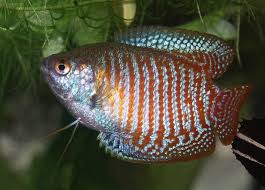
Gourami Fish
Conditions of detention
Gouramis require a well-maintained aquarium with a minimum of 20 gallons, although larger tanks are preferable, especially for the larger species. They prefer water temperatures between 72-82°F (22-28°C) and slightly acidic to neutral water with a pH of 6.0 to 7.5. Gouramis appreciate a tank with plenty of plants, floating vegetation, and hiding spots created by rocks or driftwood. They prefer gentle water flow and access to the water surface for breathing.
Useful Fact: Gouramis have a labyrinth organ that allows them to breathe air directly from the surface, so it’s important to ensure they have easy access to the water surface.
Nutrition and diet
Gouramis are omnivorous and require a varied diet. They do well on high-quality flake or pellet food, supplemented with live or frozen foods such as brine shrimp, bloodworms, and daphnia. They also enjoy vegetable matter, which can be provided through blanched spinach, lettuce, or spirulina-based foods.
Useful Fact: Feeding Gouramis a varied diet that includes both protein and plant matter helps maintain their vibrant coloration and overall health.
Health
Gouramis are generally hardy fish but can be susceptible to diseases such as ich, fin rot, and bacterial infections, especially if water quality is poor. They can also suffer from stress-related illnesses if housed with aggressive tankmates or in tanks with inadequate hiding spots.
Useful Fact: Regular water changes and maintaining stable water conditions are crucial for preventing health issues in Gouramis.
Grooming and care
Gouramis do not require traditional grooming, but their environment needs to be kept clean. Regular water changes, monitoring water parameters, and maintaining a clean tank are essential to their care.
Useful Fact: Gouramis appreciate a well-planted tank, which not only provides them with hiding spots but also helps keep the water quality high by absorbing nitrates.
Education and training
Gouramis can learn to recognize their owners and may come to the surface during feeding times. They are not typically trained to perform tricks, but they are curious and can be conditioned to respond to certain stimuli, such as the sound of food being added to the tank.
Useful Fact: Gouramis are intelligent and can become interactive, often approaching the front of the tank when they see their owners.
Toys and entertainment
Gouramis enjoy exploring their environment, so providing them with live plants, driftwood, and other decorations gives them plenty of places to explore and hide. They also benefit from floating plants, which mimic their natural habitat.
Useful Fact: Floating plants are especially appreciated by Gouramis, as they like to build bubble nests among them, particularly during breeding.
Safety
Gouramis are generally peaceful fish but can become territorial, especially males during breeding. It’s important to provide plenty of space and hiding spots to reduce stress and potential aggression. They do well with other peaceful fish but should not be housed with fin-nipping or overly aggressive species.
Useful Fact: To prevent aggression, it’s best to keep only one male Gourami per tank unless the tank is large enough to provide sufficient territories.
Accessories
Essential accessories for a Gourami tank include a reliable filter, a heater to maintain a stable temperature, and a light source that supports plant growth. Plants, both live and artificial, provide hiding spots and reduce stress. Floating plants are particularly beneficial.
Useful Fact: Gouramis benefit from subdued lighting, which can be achieved with the use of floating plants that help diffuse the light.
Socialization
Gouramis are social but can be territorial, especially males. They do well in community tanks with other peaceful fish of similar size. However, it’s important to monitor interactions closely, particularly if multiple males are kept together, as they may display aggressive behaviors.
Useful Fact: Keeping Gouramis with other non-aggressive species like tetras, rasboras, or small catfish can create a harmonious community tank.
Travel and Transportation
When transporting Gouramis, use a plastic bag filled with water from their tank and ensure it is well-oxygenated. Transport them carefully to avoid temperature fluctuations and stress. Keep the bag in a dark, insulated container to minimize stress.
Useful Fact: Gouramis are more sensitive to temperature changes, so ensure that they are acclimated slowly to their new environment after transport.
Behavior and psychology
Gouramis are known for their peaceful nature, although they can become territorial during breeding. They are curious fish that enjoy exploring their environment and interacting with their tankmates. Males are known for building bubble nests at the water surface, especially when they are ready to breed. Gouramis are also known for their unique communication behavior, where they produce sounds by grinding their teeth or using their swim bladder.
Useful Fact: Male Gouramis can be identified by their brighter colors and the construction of bubble nests, which they build to attract females during breeding.
Legal aspects
There are generally no legal restrictions on owning Gouramis, but it’s important to ensure they are sourced from reputable breeders or suppliers. This helps ensure the fish are healthy and raised in ethical conditions.
Useful Fact: Many Gouramis available in the aquarium trade are captive-bred, which helps reduce the pressure on wild populations and often results in hardier fish.


